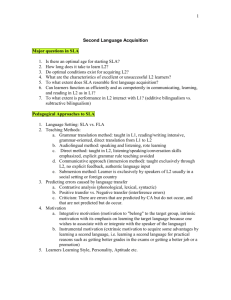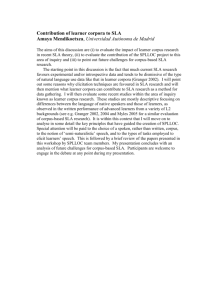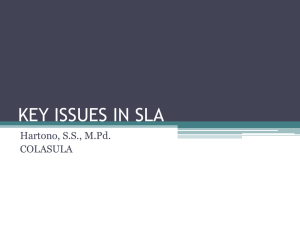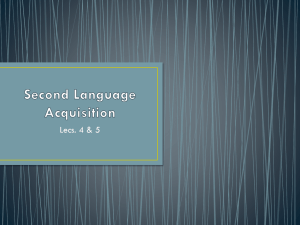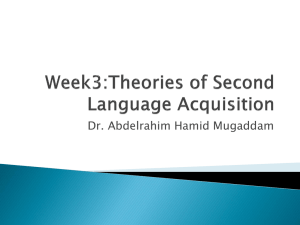Introducing Second Language Acquisition
advertisement
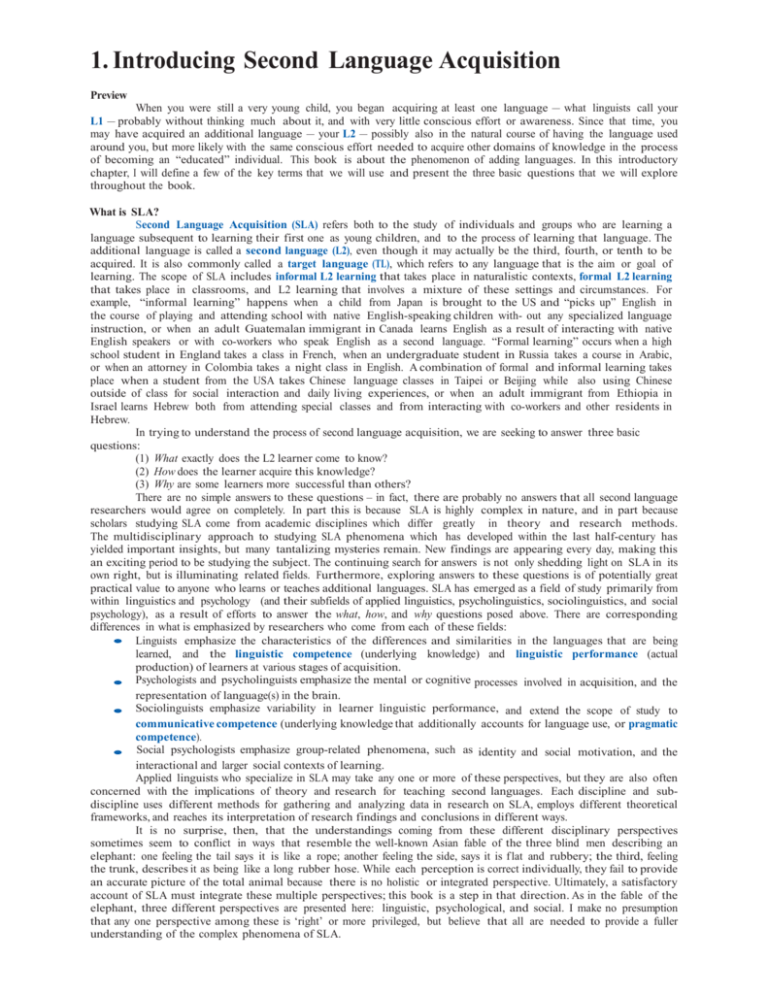
1. Introducing Second Language Acquisition Preview When you were still a very young child, you began acquiring at least one language — what linguists call your L1 — probably without thinking much about it, and with very little conscious effort or awareness. Since that time, you may have acquired an additional language — your L2 — possibly also in the natural course of having the language used around you, but more likely with the same conscious effort needed to acquire other domains of knowledge in the process of becoming an “educated” individual. This book is about the phenomenon of adding languages. In this introductory chapter, I will define a few of the key terms that we will use and present the three basic questions that we will explore throughout the book. What is SLA? Second Language Acquisition (SLA) refers both to the study of individuals and groups who are learning a language subsequent to learning their first one as young children, and to the process of learning that language. The additional language is called a second language (L2), even though it may actually be the third, fourth, or tenth to be acquired. It is also commonly called a target language (TL), which refers to any language that is the aim or goal of learning. The scope of SLA includes informal L2 learning that takes place in naturalistic contexts, formal L2 learning that takes place in classrooms, and L2 learning that involves a mixture of these settings and circumstances. For example, “informal learning” happens when a child from Japan is brought to the US and “picks up” English in the course of playing and attending school with native English-speaking children with- out any specialized language instruction, or when an adult Guatemalan immigrant in Canada learns English as a result of interacting with native English speakers or with co-workers who speak English as a second language. “Formal learning” occurs when a high school student in England takes a class in French, when an undergraduate student in Russia takes a course in Arabic, or when an attorney in Colombia takes a night class in English. A combination of formal and informal learning takes place when a student from the USA takes Chinese language classes in Taipei or Beijing while also using Chinese outside of class for social interaction and daily living experiences, or when an adult immigrant from Ethiopia in Israel learns Hebrew both from attending special classes and from interacting with co-workers and other residents in Hebrew. In trying to understand the process of second language acquisition, we are seeking to answer three basic questions: (1) What exactly does the L2 learner come to know? (2) How does the learner acquire this knowledge? (3) Why are some learners more successful than others? There are no simple answers to these questions – in fact, there are probably no answers that all second language researchers would agree on completely. In part this is because SLA is highly complex in nature, and in part because scholars studying SLA come from academic disciplines which differ greatly in theory and research methods. The multidisciplinary approach to studying SLA phenomena which has developed within the last half-century has yielded important insights, but many tantalizing mysteries remain. New findings are appearing every day, making this an exciting period to be studying the subject. The continuing search for answers is not only shedding light on SLA in its own right, but is illuminating related fields. Furthermore, exploring answers to these questions is of potentially great practical value to anyone who learns or teaches additional languages. SLA has emerged as a field of study primarily from within linguistics and psychology (and their subfields of applied linguistics, psycholinguistics, sociolinguistics, and social psychology), as a result of efforts to answer the what, how, and why questions posed above. There are corresponding differences in what is emphasized by researchers who come from each of these fields: Linguists emphasize the characteristics of the differences and similarities in the languages that are being learned, and the linguistic competence (underlying knowledge) and linguistic performance (actual production) of learners at various stages of acquisition. Psychologists and psycholinguists emphasize the mental or cognitive processes involved in acquisition, and the representation of language(s) in the brain. Sociolinguists emphasize variability in learner linguistic performance, and extend the scope of study to communicative competence (underlying knowledge that additionally accounts for language use, or pragmatic competence). Social psychologists emphasize group-related phenomena, such as identity and social motivation, and the interactional and larger social contexts of learning. Applied linguists who specialize in SLA may take any one or more of these perspectives, but they are also often concerned with the implications of theory and research for teaching second languages. Each discipline and subdiscipline uses different methods for gathering and analyzing data in research on SLA, employs different theoretical frameworks, and reaches its interpretation of research findings and conclusions in different ways. It is no surprise, then, that the understandings coming from these different disciplinary perspectives sometimes seem to conflict in ways that resemble the well-known Asian fable of the three blind men describing an elephant: one feeling the tail says it is like a rope; another feeling the side, says it is f lat and rubbery; the third, feeling the trunk, describes it as being like a long rubber hose. While each perception is correct individually, they fail to provide an accurate picture of the total animal because there is no holistic or integrated perspective. Ultimately, a satisfactory account of SLA must integrate these multiple perspectives; this book is a step in that direction. As in the fable of the elephant, three different perspectives are presented here: linguistic, psychological, and social. I make no presumption that any one perspective among these is ‘right’ or more privileged, but believe that all are needed to provide a fuller understanding of the complex phenomena of SLA. What is a second language? I have broadly defined the scope of SLA as concerned with any phenomena involved in learning an L2. Sometimes it is necessary for us to make further distinctions according to the function the L2 will serve in our lives, since this may significantly affect what we learn. These differences may deter- mine the specific areas of vocabulary knowledge we need, the level of grammatical complexity we have to attain, and whether speaking or reading skills are more important. The following are distinctions commonly made in the literature: • A second language is typically an official or societally dominant language needed for education, employment, and other basic purposes. It is often acquired by minority group members or immigrants who speak another language natively. In this more restricted sense, the term is contrasted with other terms in this list. • A foreign language is one not widely used in the learners’ immediate social context which might be used for future travel or other cross-cultural communication situations, or studied as a curricular requirement or elective in school, but with no immediate or necessary practical application. • A library language is one which functions primarily as a tool for further learning through reading, especially when books or journals in a desired field of study are not commonly published in the learners’ native tongue. • An auxiliary language is one which learners need to know for some official functions in their immediate political setting, or will need for purposes of wider communication, although their first language serves most other needs in their lives. Other restricted or highly specialized functions for ‘second’ languages are designated language for specific purposes (such as French for Hotel Management, English for Aviation Technology, Spanish for Agriculture, and a host of others), and the learning of these typically focuses only on a narrow set of occupation-specific uses and functions. One such prominent area is English for Academic Purposes (EAP). What is a first language? There is also sometimes a need to distinguish among the concepts first language, native language, primary language, and mother tongue, although these are usually treated as a roughly synonymous set of terms (generalized as L1 to oppose the set generalized as L2). The distinctions are not always clear-cut. For purposes of SLA concerns, the important features that all shades of L1s share are that they are assumed to be languages which are acquired during early childhood – normally beginning before the age of about three years – and that they are learned as part of growing up among people who speak them. Acquisition of more than one language during early childhood is called simultaneous multilingualism, to be distinguished from sequential multilingualism, or learning additional languages after L1 has already been established. (‘Multilingualism’ as used here includes bilingualism.) Simultaneous multilingualism results in more than one “native” language for an individual, though it is undoubtedly much less common than sequential multilingualism. It appears that there are significant differences between the processes and/or results of language acquisition by young children and by older learners, although this is an issue which is still open to debate, and is one of those which we will explore in chapters to follow. Diversity in learning and learners As already noted, the circumstances under which SLA takes place sometimes need to be taken into account, although they are perhaps too often taken for granted and ignored. What is learned in acquiring a second language, as well as how it is learned, is often influenced by whether the situation involves informal exposure to speakers of other languages, immersion in a setting where one needs a new language to meet basic needs, or formal instruction in school, and these learning conditions are often profoundly influenced by powerful social, cultural, and economic factors affecting the status of both languages and learners. The intriguing question of why some L2 learners are more successful than others requires us to unpack the broad label “learners” for some dimensions of discussion. Linguists may distinguish categories of learners defined by the identity and relationship of their L1 and L2; psycholinguists may make distinctions based on individual aptitude for L2 learning, personality factors, types and strength of motivation, and different learning strategies; sociolinguists may distinguish among learners with regard to social, economic, and political differences and learner experiences in negotiated interaction; and social psychologists may categorize learners according to aspects of their group identity and attitudes toward target language speakers or toward L2 learning itself. All of these factors and more will be addressed in turn in the following chapters. Summary Second Language Acquisition (SLA) involves a wide range of language learning settings and learner characteristics and circumstances. This book will consider a broad scope of these, examining them from three different disciplinary perspectives: linguistic, psychological, and social. Different approaches to the study of SLA have developed from each of these perspectives in attempts to answer the three basic questions: What exactly does the L2 learner come to know? How does the learner acquire this knowledge? Why are some learners more (or less) successful than others?
